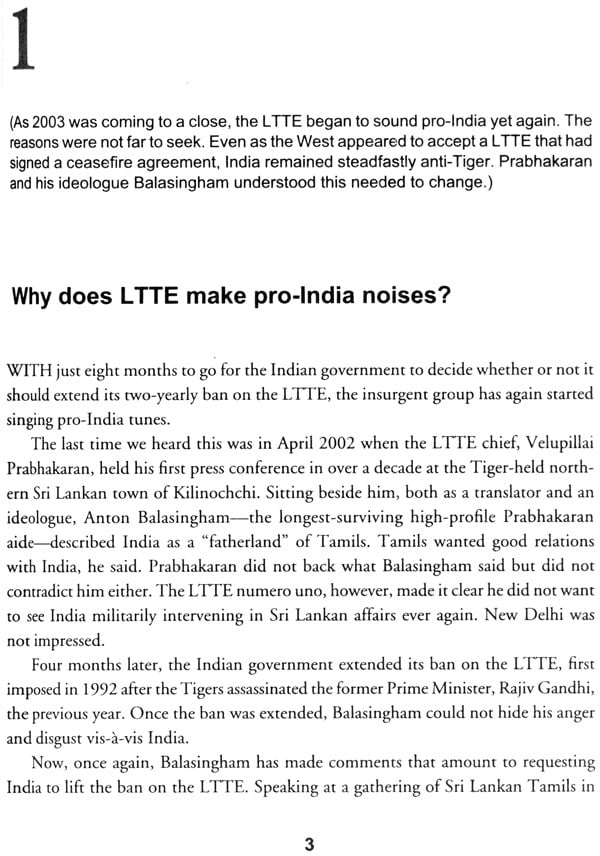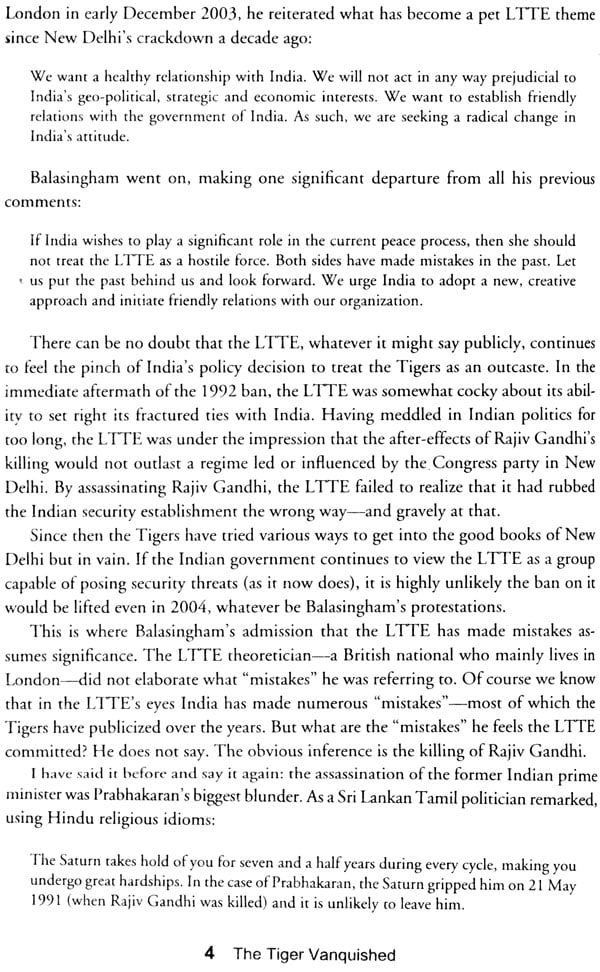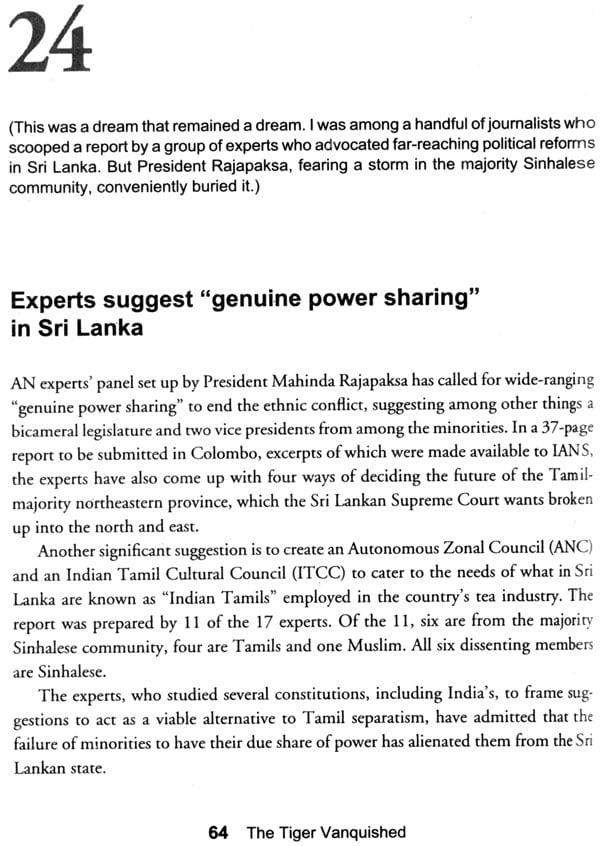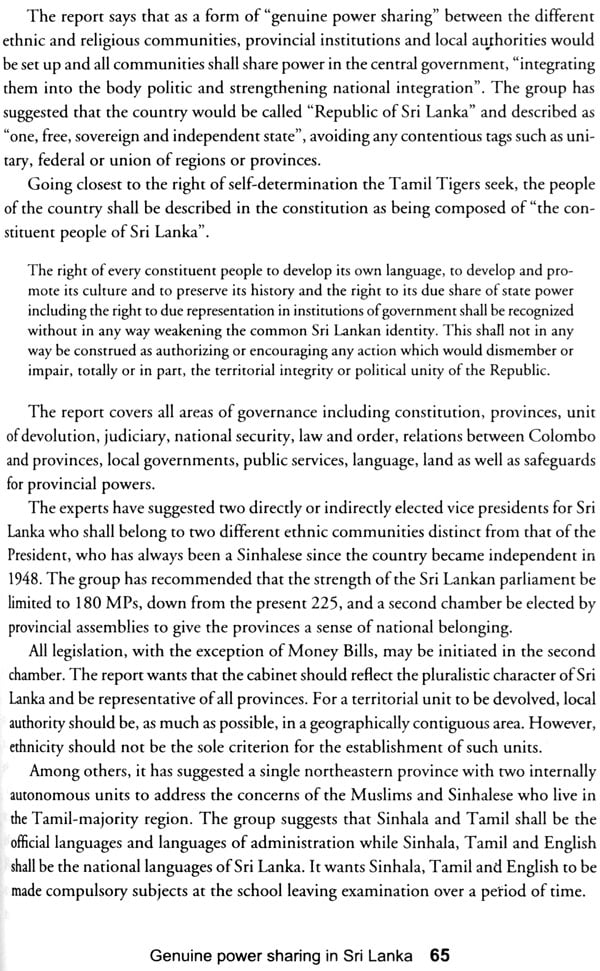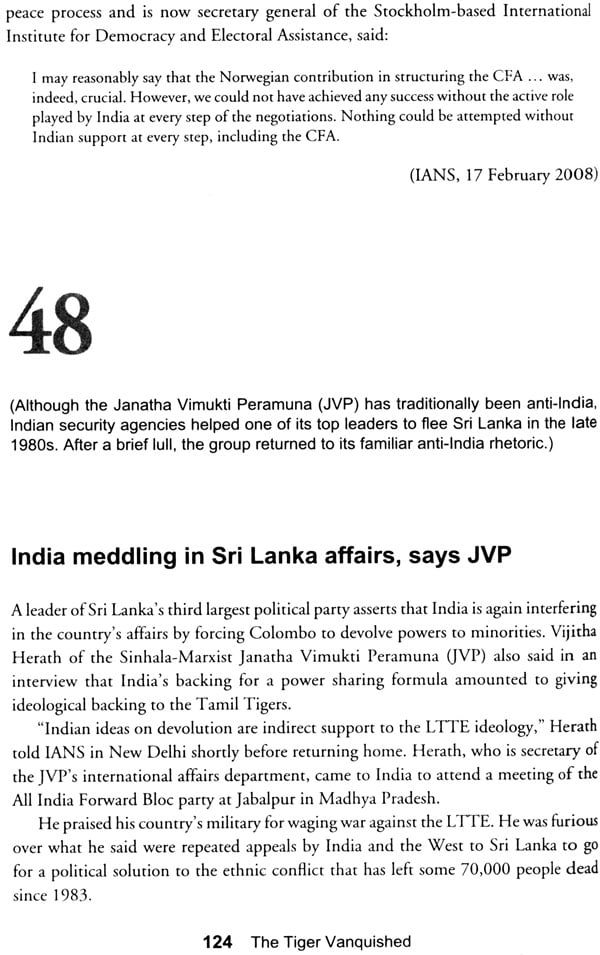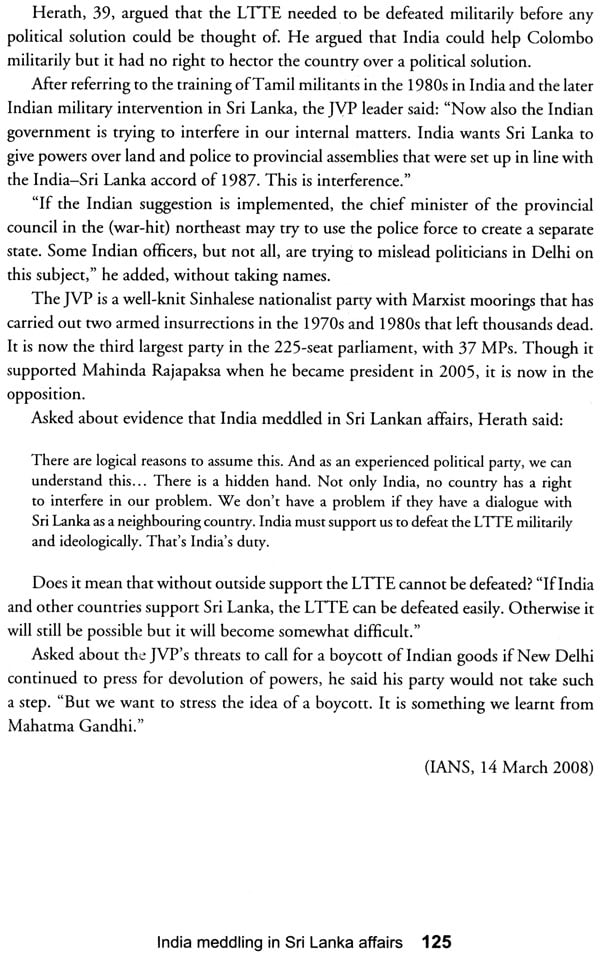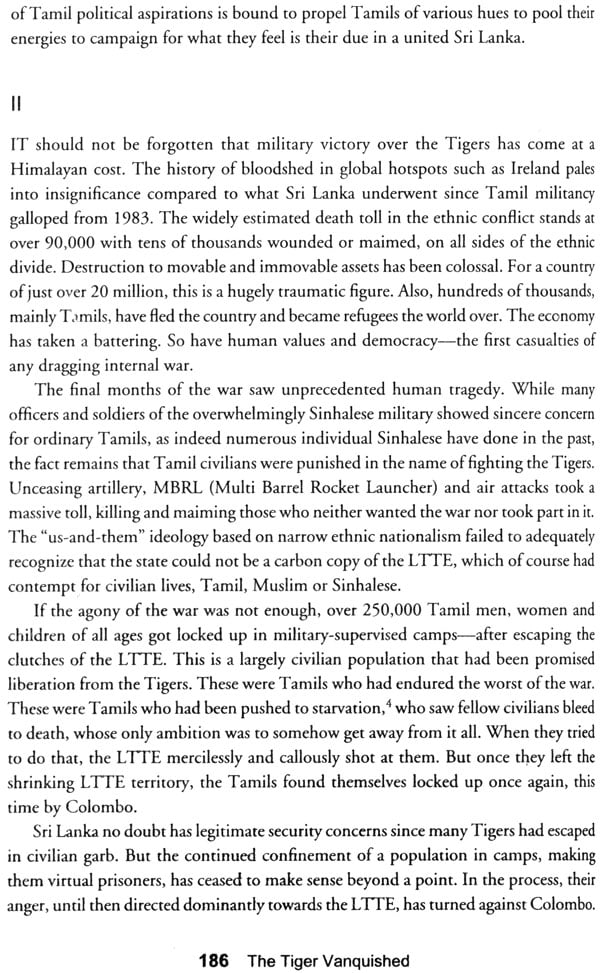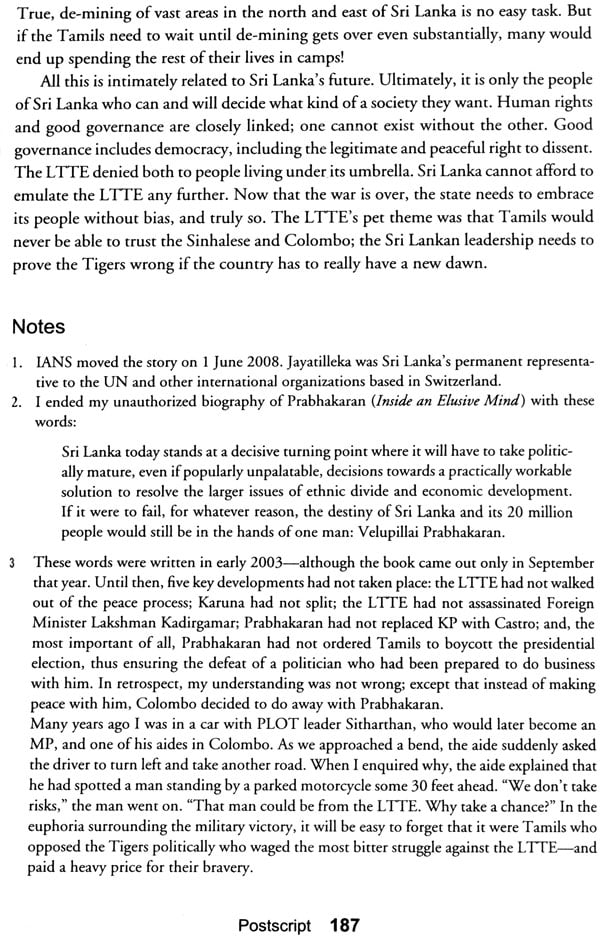
The Tiger Vanquished (Ltte's Story)
Book Specification
| Item Code: | NAG952 |
| Author: | M R Narayan Swamy |
| Publisher: | Sage Publications India Pvt. Ltd. |
| Language: | English |
| Edition: | 2011 |
| ISBN: | 9788132104599 |
| Pages: | 272 |
| Cover: | Paperback |
| Other Details | 8.0 inch X 5.5 inch |
| Weight | 300 gm |
Book Description
This book tells the story of why the Liberation Tigers of Tamil Eelam (LTTE) lost the war that they had always dreamt of winning in Sri Lanka. It is a collection of news stories and commentaries penned by the author from 2003 to 2009 on the ethnic conflict in the country. Each piece is provided with an introduction that places it in the context in which it was written. The unfolding of the drama is brought about through conversations with Sri Lankan leaders, Tamil activists, Indian officials, Norwegian and other diplomats, human rights activists, former LITE guerrillas and civilians.
The Tiger Vanquished: LTTE's Story provides a detailed account of the critical years when Sri Lanka's internationally backed peace process slowly led to a vicious war that the LITE decisively lost. The introduction provides previously unpublished information, including India's covert involvement in the Norwegian-sponsored peace process and the silent war that the Indian intelligence waged against the LTTE. Also, among other things, an inside account of what went wrong with the Tigers is given by two young women who served in the LITE.
A graduate of Delhi University, M R Narayan Swamy took to journalism in 1978. He began his career with the United News of India (UNI), a premier Indian news agency. After over eight years, he switched over to the French international news agency AFP where he served for more than 13 years. And after a stint in Singapore, he returned to India and joined the IANS news agency in 2001, where he is now the Executive Editor. Narayan Swamy is the author of two previous and path-breaking books on Sri Lanka. The first, Tiger of Lanka (1994), details the origins and growth of Tamil militancy, including India's overt and covert involvement. The second, Inside an Exclusive Mind (2003), is the only biography albeit unauthorized of the now dead LTTE chief, Velupillai Prabhakaran. Both books are considered a must read for all those trying to understand Tamil militancy in Sri Lanka.
I
The surreal end of Velupillai Prabhakaran and almost all his senior lieutenants at one go marked the most dramatic and unexpected decimation of the seemingly indestructible Tamil Tigers, bringing down the curtains on one of the world's longest running insurgencies that had torn apart Sri Lanka for over a quarter century.
Year after year, it had looked as if Tamil militancy would never end in the once idyllic Indian Ocean island nation and the Liberation Tigers of Tamil Eelam (LTTE) would never breathe its last. Successive governments in Sri Lanka, of course, tried to crush the Tigers, only to get badly bruised, at times to the point of humiliation. In the process, the LITE's image, as an outfit that cannot be defeated by anyone, only got reinforced, making it the most feared, fanatic and ruthless outlaw, its ability to destroy, next only to Al Qaeda's.
Yet, in the scorching month of May 2009, what for long had seemed impossible, was made possible by a barely four-year-old regime in Sri Lanka sworn to stamp out the L TIE. When he took over the presidency in November 2005, Mahinda Rajapaksa, a Sinhalese Buddhist politician from the country's deep south, confided to an Asian diplomat- he counted as a friend that one of his priorities was to decimate the awesome LITE. As the war progressed, Rajapaksa went public with that claim. In the light of Sri Lanka's past quarter century when the LITE had only grown from strength to strength, few took him seriously.
But Rajapaksa was deadly serious. In an earlier decade, the man had passionately battled human rights abuses by security forces when thousands of youths were butchered in the wake of an insurrection launched by the Sinhalese-Marxist group, Janatha Vimukti Peramuna (JVP).The times were now different. He was presiding over a conflict-torn country whose fortunes seemed wedded to the whims and fancies of a Tamil man called Prabhakaran. Like the newly elected president, Prabhakaran too was a determined man. But his aim was different. He had pledged to break up Sri Lanka.
A school dropout with low intellect but with a passion and precision for violence.
Prabhakaran had been calling the shots in Sri Lanka both during phases of war and ceasefire since giving birth to the LTTE in 1976. Rajapaksa knew this and was determined to chart a path different from his predecessors-one that Prabhakaran would not be able to influence. Fortunately for him, the L TIE chief ignited the spark that led to the final of Eelam wars? that finished off the Tigers, lock, stock, and barrel, near a lagoon in Mullaitivu district, which until then had been Prabhakaran's seemingly impregnable hideout.
After declaring in his annual speech of November 2005 that he would give Rajapaksa a year to prove his sincerity vis-a-vis the Tamils, Prabhakaran did not wait even for a month before beginning to militarily provoke the new president. It was a foolish move. It helped to convince Rajapaksa that the assessment of the LTTE provided by his aides was right. Prabhakaran's publicly stated loyalty to peace was sham. Further negotiations with the Tigers would not lead Sri Lanka anywhere. The external peace facilitator, Norway's, passion for negotiations was based on wrong surmises. The time had come for the president to make history. The single-minded Rajapaksa did just that.
I was one of the journalists who covered that blood-soaked story, albeit from a distance.
II
RAJAPAKSA was not only a determined and calculating politician but also a lucky one. One of his predecessors, Ranasinghe Premadasa, had been blown up by the LTTE in 1993 after trying to make peace with the group. Another head of state who had a long-standing sympathizer of Tamil grievances, Chandrika Kumaratunga, lost eye during a suicide bombing aimed at killing her. Yet another, Junius Jayewarden otherwise considered a wily fox, had earlier gone politically bankrupt fighting the Tigers. Fortunately for Rajapaksa, even before he took over the reins of Sri Lanka. luck had slowly begun to desert Prabhakaran, after being on his side for an unusually long, long time.
When Rajapaksa became the head of state in 2005, Prabhakaran remained arrogantly confident of success in the long run, notwithstanding an unexpected and crippling split in the LTTE the previous year. The Tigers were an unusual cocktail of classical insurgency and sheer terror. Besides being the only insurgent outfit to own a shipping fleet (after the PLO-Palestine Liberation Organization-and IRA-Irish Republican Army), the LTTE had its own army, a small but lethal naval wing, a nascent air force, artillery units, a feared intelligence wing, a police force, a clandestine radio, and an efficient logistics division to buy and ferry war material from around the world in the most secretive and sophisticated manner. The group's tentacles reached almost every country. And the LTTE had proved its mettle by repeatedly harassing the Sri Lankan military-and for over two years the much bigger Indian Army too.
More importantly, the LTIE had an elite corps of suicide bombers known as Black Tigers. Whenever Prabhakaran wished, he could dispatch one or more of them to extinguish a foe of Tamil Eelam, real or perceived, Sinhalese or Tamil, Sri Lankan or Indian. The LTIE's ability to kill any key person, in the military or the government, inevitably dented the state's counter-insurgency, making Prabhakaran look exactly like his childhood comic hero--the Phantom, the masked jungle hero who could never be vanquished.
More often that not, the suicide bombers succeeded in their grotesque missions, blowing up themselves as well as their intended victims. Married to the belief that aggression pays, Prabhakaran picked Sarath Fonseka, the Sri Lankan army chief and a man close to Rajapaksa, as his first VVIP victim in the new Rajapaksa government. If Fonseka were to get killed, it would deal a huge blow to Colombo and surely derail the war machine that was taking shape.
The chosen killer was a young woman who managed to gain entry into the other- wise impregnable army headquarters in Colombo by pretending to be pregnant. She attended prenatal maternity classes at a hospital within the army complex. The subsequent arrest of a senior L TIE operative revealed that the entire plan was drawn up after detailed and meticulous study of the area and the intended victim's routine. The L TIE intelligence had also befriended a Tamil-speaking Muslim cook in the army to gain access to the complex. Prabhakaran gave the final green signal. The attack took place in April 2006 or just five months after Rajapaksa had assumed office.
The woman's audacious attempt to kill Fonseka by detonating explosives strapped to her body-a methodology first tried successfully in May 1991 on Rajiv Gandhi, the former prime minister of India-however failed. An alert guard riding a motorcycle kicked away the suicide bomber as she tried to get close to the army chief's car. But nothing could prevent the human bomb from exploding. She died instantly-along With eight bodyguards of the army commander.
The huge fireball triggered by the deafening blast, seriously injured Fonseka. Unfortunately for Prabhakaran, the veteran soldier was not destined to die. Fonseka, who had always held the LTTE in contempt, miraculously survived. He returned to his Job following months of medical care in the country and abroad. Fonseka was now a wounded lion, determined to avenge his humiliation.
For Rajapaksa, the attempted assassination was a personal affront. By then the LTTE had gone berserk. It killed soldiers and targeted high value military personnel, including those from the intelligence-the eyes and ears of Colombo. The armed forces, sick of a Norwegian-brokered ceasefire agreement they felt was loaded in favour of the L TIE and spoiling for a fight, retaliated without mercy. As in the past, the Tigers were in a hurry to influence events as they wished.
As ill luck would have it, the L TIE failed to accurately read the mindset of the enemy and went on to commit a blunder that was to push it to its gory end.
The Tigers closed down a sluice gate in an area they held in the eastern province, depriving irrigation water to thousands of farmers, mostly from the majority Sinhalese community living in the adjoining government zone. It quickly became a highly emotive issue. Conveniently, the Tigers denied responsibility; the Tamil people, the LTTE argued with an air of sarcasm, were acting on their own. Anyone who, had even an inkling of the rebels knew that nothing could happen behind the Tigers Iron curtain without their nod.
The LTTE's refusal to back down despite international appeals formally triggered what came to be known as "Eelam War IV" the final of the wars for a Tamil state that ended in May 2009 with the Tigers' ignominious defeat. Sporadic incidents that international actors overseeing the tottering peace process had assumed, could be tamed spiralled out of control. The military concluded, after four long years of uneasy ceasefire, that enough was enough and that the L TIE needed to be taught a lesson it would not forget.
The LTTE probably realized, somewhat late, that it had made a mistake. It was too late though. As the two antagonists took on one another in the east of Sri Lanka, a region where Tamils, Sinhalese and Muslims lived in almost equal numbers, the intensity of their fighting betrayed their unmasked hatred for one another. It was clear that the war this time would be different.
It was. The LTTE had carefully prepared for a showdown during the Norway sponsored and internationally backed peace process that began formally in February 2002. One will not be too far off the mark to say in retrospect that if the devastating tsunami had not hit Sri Lanka in December 2004, the Tigers may have gone on the offensive around that time. War was very much in the air then.
Once large-scale fighting broke out in 2006, it dawned on Prabhakaran that Colombo too had psychologically prepared itself for war. Rajapaksa was ready to pay back in a fitting manner, whatever the consequences. Half-hearted peace talks held in Norway and Switzerland that year collapsed as quickly as they started. They were perhaps not meant to succeed.
Like in earlier times, capital Colombo became a fortress. The LTTE meant business. Bombs went off in areas far removed from the conflict theatre, killing innocents. Sri Lanka unleashed its air force and artillery barrages on LTIE areas like never before. For once, the state decided that it needed to be an LTTE to defeat the LTTE. Anyone with the slightest of suspected links with the LTTE got picked up. Abductions in government areas became rampant as the government embraced unconventional methods to break the LTIE's very deadly sleeper network. Many victims simply disappeared. The bodies of others turned up in unlikely places, at times with their hands tied and with bullets in their head. The media was muzzled.
In the east, the LTTE found itself on the defensive, thanks considerably to the breakaway group led by its former regional commander Vinayagamurthy Muralitharan alias Karuna. Forcible recruitment of children soared. Sri Lanka's war had become as dirty as it could. The Ceasefire Agreement of 2002, brokered by Norway between the government and the LITE after months of painstaking backroom diplomacy, began to come apart, much to the dismay of the international community.
After failing to kill the army chief, Prabhakaran now tried to do away with Gotabaya Rajapaksa, the man spearheading Sri Lanka's war and a younger brother of the President. This was in December 2006. From Prabhakaran's perspective, killing Gotabaya Rajapaksa would fetch far greater dividends. It would surely destabilize Sri Lanka's war machinery. Unfortunately for Prabhakaran, he too survived miraculously although the attempt shook him up. It was a momentous event that ultimately would prove very costly to Prabhakaran.
It can be said without an iota of doubt that the attempt to blow up the younger Rajapaksa, on a Colombo street, was the most decisive turning point in the war against the LTTE. As a retired Sri Lankan army officer, who was an American citizen, he' had returned to Colombo ahead of the 2005 presidential elections. After Mahinda Rajapaksa won, he had asked Gotabaya to stay on. Having fought the LITE when he was in the army, Gotabaya Rajapaksa had a clear vision as much as the insurgent Outfit was concerned. A no-nonsense man, he had firmed up much earlier that the only language the LTTE understood and respected was that of force. And that is what Colombo would now employ.
The attempt to kill Gotabaya Rajapaksa only steeled his resolve-and that of President Mahinda Rajapaksa-to go for the kill. They were now more than convinced that Prabhakaran and the band of men and women who made up the LTTE could never be trusted. As the army chief Fonseka would say later, using the terminology of cricket, a game that united Sri Lanka like perhaps nothing else, the government Concluded that it would play for certain victory, not for a draw.
From then on, Sri Lanka would contemptuously reject the parrot-like suggestions at there could only be a negotiated end to the conflict. In the process, for the first time, Colombo took on not only Western countries but also international institutions, at times accusing them of bias towards the L TIE. Human rights activists were treated with contempt. The pontification from the Indian government about political and constitutional reforms was tolerated. But Sri Lanka was far less approving of the pro-LTIE noises made in Tamil Nadu, the Indian state separated from the island nation by a narrow strip of sea. Sri Lanka's unprecedented aggression, in the battlefield and in the diplomatic arena, stunned the L TIE leadership, which had expected the Rajapaksa regime to capitulate.
President Rajapaksa had other ideas. He would do what no government in Colombo had done before. He went for Prabhakaran's jugular. It would be do or die.
From the day he survived, it took Gotabaya Rajapaksa and a resurgent Sri Lankan military that reported to him just two and a half years to finish off the LTTE, an octopus that had played havoc for over a quarter century. It was nothing short of a miracle. May 2009 witnessed the macabre end of a horribly bloody saga that had brutalized Sri Lanka since 1983 and divided it ethnically, fractured its soul, claimed more than 90,000 lives, wounded and maimed thousands, and created a huge Tamil refugee population within the country and all across the world.
| Acknowledgements | xi | |
| Key years in LTTE history | xiii | |
| The final conversation: May 2009 | xv | |
| Introduction | xvii | |
| Testimonies of LTTE cadres | lxxiii | |
| Testament I-Saroja's story | 3 | |
| Testament II-Vani's story | 8 | |
| 2003-2005 | 14 | |
| 1 | Why does LTTE make pro-India noises? | 16 |
| 2 | Turmoil in Tiger land | 18 |
| 3 | "Only a snake understands a snake" | 20 |
| 4 | Can tsunami bring peace to Sri Lanka? | 24 |
| 5 | The tsunami, and Prabhakaran | 26 |
| 6 | Tribute: Shankar Rajee | 31 |
| 7 | Kadirgamar assassination will kill peace process | 33 |
| 8 | Norway has to recalibrate Sri Lanka peace process | 35 |
| 2006 | 37 | |
| 9 | Switzerland taking deep interest in Sri Lanka | 40 |
| 10 | Solheim not to quit peace process | 42 |
| 11 | India clawing back to Sri Lanka's northeast | 44 |
| 12 | A book is a window to knowledge | 46 |
| 13 | Indian PM urges Rajapaksa to save Tamils in Trincomalee | |
| 14 | Suicide bomber blows up Sri Lanka's peace process | |
| 15 | Prabhakaran's pride: Or why he refused to meet Akashi | |
| 16 | Co-chairs' forthright Sri Lanka edict will please India | |
| 17 | Indian trader brutally killed, two missing in Sri Lanka | 48 |
| 18 | Pro-LTTE website attacks Karunanidhi | 51 |
| 19 | Armed with parrots, Tamil girl flees to India | 53 |
| 20 | In war torn Sri Lanka, a widow remembers | 55 |
| 21 | Be patient please, Sri Lanka to tell India | 57 |
| 22 | Faltering Sri Lankan peace process | 59 |
| 23 | Solheim calls Karuna allegations "complete lies" | 62 |
| 24 | Experts suggest "genuine power sharing" in Sri Lanka | 64 |
| 25 | Balasingham epitomized LTTE's love-hate ties with India | 66 |
| 26 | Sri Lanka needs new truce agreement | 69 |
| 2007 | ||
| 27 | Why George Bush cannot match Sonia Gandhi? | 75 |
| 28 | Misery, epidemic go hand in hand in troubled Sri Lanka | 77 |
| 29 | Sri Lanka's abduction industry has top academic in its grip | 79 |
| 30 | War material seizure signal LTTE bracing for guerrilla war | 81 |
| 31 | LTTE cannot be defeated militarily, US tells Sri Lanka | 83 |
| 32 | India concerned over LTTE explosives smuggling | 86 |
| 33 | Husband dead, Tamil woman wants to return to Sri Lanka | 88 |
| 34 | A historic accord few remember today | 90 |
| 35 | On to Tamil Eelam: From bicycle to aircraft | 92 |
| 36 | Amid war, India's emerging Sri Lanka tilt | 94 |
| 37 | How to tell Tamils they don't belong to Sri Lanka? | 96 |
| 38 | Action above ideology for Black Sea Tigers | 98 |
| 39 | Use dignified language, Bhagwati tells Sri Lanka | 100 |
| 40 | Two decades later, LTTE suicide bombers live on | 102 |
| 41 | "Why no memorial for the IPKF in India?" | 104 |
| 42 | India-Sri Lanka accord: Does it still flicker? | 106 |
| 43 | Britain favours "regime change" in Sri Lanka | 110 |
| 44 | Tamilchelvan's killing a disaster to LTTE-and Sri Lanka | 112 |
| 45 | Sri Lanka gained upper hand over LTTE in 2007 | 114 |
| 2008 | ||
| 46 | LTTE man's arrest for abduction plan first since 1991 | 119 |
| 47 | India's covert role in Sri Lanka's ceasefire | 121 |
| 48 | India meddling in Sri Lanka affairs, says JVP | 124 |
| 49 | I want to bring peace to Sri Lanka: Sri Sri Ravi Shankar | 126 |
| 50 | India's Sri Lanka power project runs into Tamil storm | 128 |
| 51 | Sri Lanka cannot negotiate with LTTE, says diplomat | 130 |
| 52 | In Sri Lanka, LTTE territory shrinks and shrinks | 132 |
| 53 | We have failed to convince the world: Sri Lanka defence secretary | 134 |
| 54 | Norway-LTTE ties sour over theft ofNGO vehicles | 136 |
| 55 | India under attack in pro-LTTE media | 138 |
| 56 | Tamil Nadu ferment stuns Rajapaksa but war will go on | 140 |
| 57 | India to send 2,000 tonnes of relief goods to Sri Lanka | 142 |
| 2009 | ||
| 58 | Kilinochchi's fall a major setback to LTTE | 147 |
| 59 | Prabhakaran cannot escape from Sri Lanka, says former aide | 149 |
| 60 | After 25 years, cornered LTTE faces deathly crisis | 151 |
| 61 | Tamil man recounts tales of horror in Sri Lanka war | 153 |
| 62 | Vaiko has been an undisguised supporter of the LTTE | 155 |
| 63 | Has LTTE executed its military spokesman? | 157 |
| 64 | LTTE media targets Sonia over war debacle | 159 |
| 65 | Playing politics with Tamil lives in Sri Lanka | 161 |
| 66 | Is LTTE in secret, indirect talks with US to surrender? | 163 |
| 67 | Prabhakaran: From catapult killer to ruthless insurgent | 165 |
| 68 | Prabhakaran was with 18 men when he was killed: Karuna | 168 |
| 69 | Displaced Tamils to be resettled by 2009-end: Rajapaksa | 170 |
| 70 | Swat the fly, kill the foe | 172 |
| 71 | So, the Tamil Tigers were mortals after all... | 175 |
| 72 | How the tide turned | 177 |
| Postscript: A new dawn | 181 | |
| About the author | 189 |
